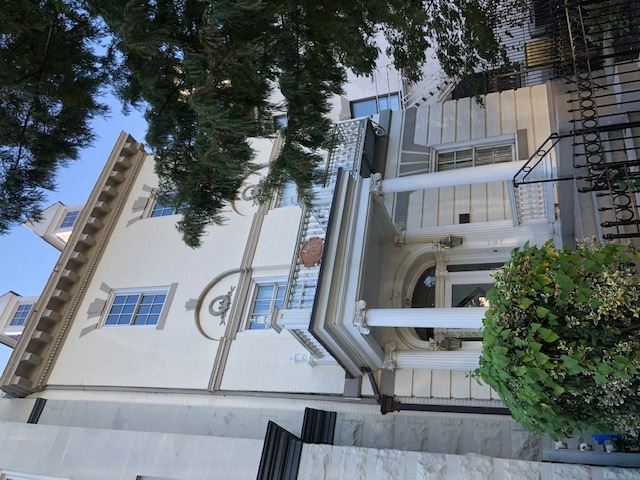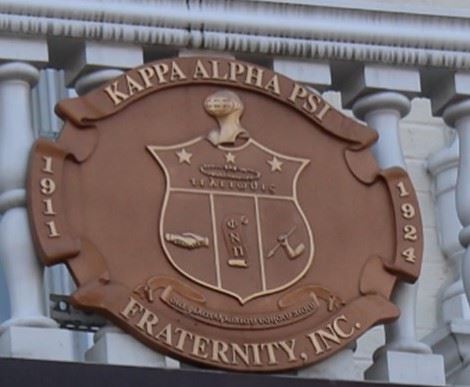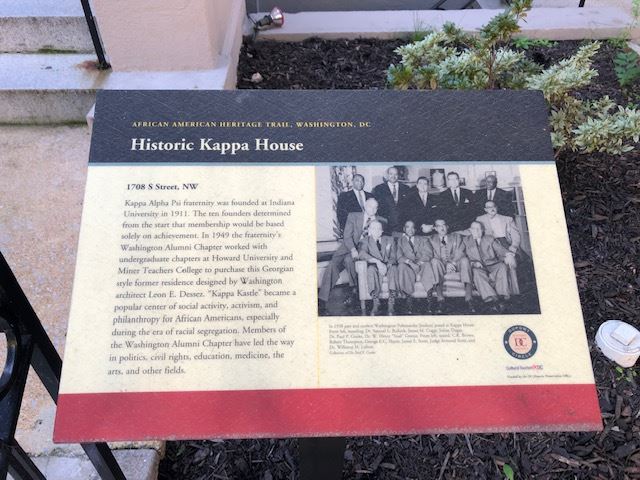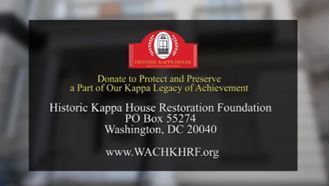- DCCA Home
- DCCA House Tour
- 1708 S Street

This four-story Georgian-style row mansion has been home to the Washington DC Alumni Chapter, Kappa Alpha Psi Fraternity (ΚΑΨ) since 1949. Completed in 1908 as a private residence, the house is accentuated by a portico over the front door flanked by four iconic Greek columns.
The home was designed by Washingtonian Leon E. Dessez (1858-1918) who began his career working on plans for the Washington Monument. Dessez also helped design the first four houses in Chevy Chase, Maryland, and became that community’s first resident. Other works by Dessez include the Admiral's Residence at One Observatory Circle (today the Vice President's house), Miner Teachers College building on Georgia Avenue, Gallinger Hospital (former DC General Hospital), and hospital at the Soldiers’ Home (now the Armed Forces Retirement Home).History of Kappa Alpha Psi.
History of Kappa Alpha Psi
Kappa Alpha Psi Fraternity Inc. (ΚΑΨ), was founded on the campus of Indiana University Bloomington as Kappa Alpha Nu on January 5, 1911,“born in an environment saturated in racism… (with) many sympathizers of the Southern cause… The state of Indiana became a stronghold for the Ku Klux Klan… Vigilante lynchings of Blacks were commonplace… some Black students sought a college education at Indiana University, as it was a tuition-free university of the highest quality… they decided that a Greek-letter fraternity would do much to fill the missing link in their college existence.” (https://kappaalphapsi1911.com/page/History).

Kappa Alpha Psi is the 2nd oldest existing collegiate historically Black Greek Letter Fraternity and the 1st intercollegiate Fraternity incorporated as a national body. The Fraternity has over 125,000 members with 700 undergraduate and alumni chapters in nearly every state of the United States, and international chapters in Nigeria, South Africa, the West Indies, the United Kingdom, Germany, Korea, and Japan.
The fraternity chapter was established at Howard University in 1920 and the Washington DC alumni chapter was founded in 1924. Two local undergraduate chapters participated in the purchase of 1708 S Street NW in 1949: the Howard University Xi Chapter and the Miner Teachers College Beta Kappa Chapter. ‘Kappa Kastle’, as it was sometimes called, became a popular center of social activity, activism, and philanthropy for African Americans, especially during the era of racial segregation.
The purchase of the property helped raise the status of the Chapter and represented powerful Black unity in a hostile and segregated city. The house was a focal point for social activities during the Jim Crow period, when most public spaces were denied to Black Americans.
A property at the center of a historic struggle against segregation
It is fitting that a major and progressive Black fraternity has a presence in this block of S street, the site of a major struggle against racist housing restrictions. Black and white families often lived next to each other in 19th century Washington, particularly in the city center. However, during the first half of the 20th century whites-only housing, playgrounds and schools were developed. Racially restrictive deed covenants were a particularly effective tool for housing segregation. They were regularly supported by the courts. In August 1921, white residents of the 1700 block of S street NW signed a legally binding agreement to restrict the sale or rental of their houses to white people, even though the row of more modest houses at the western end of this block of S street was already Black-occupied. Of the 40 addresses in the 1700 block listing in the 1921 city directory, the owners of 24 signed the covenant. In 1922, absentee owner Irene Corrigan signed a contract to sell her house at 1727 S street to Helen Curtis, of the National Association of Negro Women. White attorney John Buckley, of 1719 S street sued. In 1924, the D.C. Court of Appeals sided with Mr. Buckley, arguing that since the District’s schools and recreation facilities were segregated there were ample precedents. More substantively, it concluded that since African Americans were equally free to discriminate restrictive covenants did not violate their civil rights. Moorfield Storey, first president of the NAACP, petitioned the U.S. Supreme Court to hear the case but the Court declined, determining that the agreement was a private contract between property owners and effectively authorizing the continued and extended use of this device. (More details at https://www.dcpolicycenter.org/publications/racially-restrictive-covenants-bloomingdale/)
Despite these victories, the Dupont neighborhood has remained largely white. The 1990s scandal concerning the Chevy Chase Federal Savings Bank’s discriminatory lending practices highlighted allegations from bank staff that loan officers were directed not to provide mortgage loans south of Calvert Street NW or east of Connecticut Avenue, with exceptions for Capitol Hill and Dupont Circle. In other words, the allegation was that the Dupont Circle neighborhood was safe for white investors. Recent
census data has shown dramatic changes in the racial demography of the
city overall, but little change in Dupont Circle (shown approximately
with red circle). |
 |  |
| The DC government is considering designating this block of S Street as "Kappa Alpha Psi Way" (Bil 23-449, the "Kappa Alpha Psi Way Designation Act of 2020"). | The Historic Kappa House Restoration Foundation has undertaken extensive restoration work on this property, but further funds are needed to maintain progress. |
Other residents of the house
The report of the first session of the 59th Congress (volume 27) reports that William Bruce King was in residence at 1708 S St NW and donated to St. Mary’s Guild, a charity benefitting the Children’s hospital. Mr. King was on the Board of Trustees for George Washington University. His wife, Mrs. E. King was a rich patron of the white musical scene in Washington. She died in July 1914.
By 1915, Leonard F. Bischoff and his wife Carrie were in residence.Subsequent residential turnover seems to have been rapid and by 1917, William Malburn, Assistant Secretary of the Treasury lived at 1708 S St.
By 1945, the house had become a gallery and by 1947, shortly before its purchase by the Kappa Alpha Psi Fraternity, it was a dance studio.